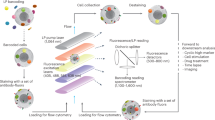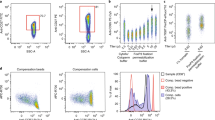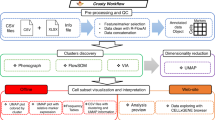Abstract
The analysis of macromolecular interactions is an essential element of biomedical research. Flow cytometry is uniquely capable of making sensitive and quantitative measurements of molecular interactions. These measurements can be made in real time with subsecond kinetic resolution using purified biomolecules or living cells. Combined with automated sample handling, these features make flow cytometry a versatile and robust technology for the analysis of molecular interactions.
This is a preview of subscription content, access via your institution
Access options
Subscribe to this journal
Receive 12 print issues and online access
$209.00 per year
only $17.42 per issue
Buy this article
- Purchase on Springer Link
- Instant access to full article PDF
Prices may be subject to local taxes which are calculated during checkout
Similar content being viewed by others
References
Melamed, M., Lindmo, T., Mendelsohn, M. 1990. Flow cytometry and sorting. Wiley-Liss Inc., New York.
Shapiro, H. M. 1995. Practical flow cytometry. Wiley-Liss Inc., New York.
Lauffenberger, D.A., Linderman, J.J. 1993. Receptors: models for binding, trafficking, and signaling. Oxford University Press, New York.
Johnson, K.A. 1992. Transient-state kinetic analysis of enzyme reaction pathways. pp. 1–61 in The enzmes, Vol.20. Academic Press, New York.
Etfink, M.R. 1997. Fluorescence methods for studying equilibrium macromolecu-lar-ligand interactions . Methods Enzymol. 278: 221–416.
Hill, J. J., and Royer, C. A. 1997. Fluorescence approaches to study of protein nucleic acid complexation. Methods Enzymol. 278: 390–416.
Sklar, L.A. 1987. Real-time spectroscopic analysis of ligand-receptor dynamics Ann. Rev. Biophys. Biophys . Chem. 16: 479–506.
Jonsson, U., Fagerstam, L., Ivarsson, B., Johnsson, B., Karlsson, R., Lundh, K. et al. 1991. Real-time biospecific interaction analysis using surface plasmon resonance and a surface chip technology. BioTechniques 11: 620–627.
Davies, R.D., Edwards, P.R., Watts, J.H., Lowe, C.R., Buckle, P.E., Yeung, E. et al. 1994. The resonant mirror a tool for the study of biomolecular interactions Techniques Prot . Chem. V: 285–292.
Martin, J.C., Schwartzenruber, D.E. 1980. Time: a new parameter for flow cytometry. Science. 207: 199–201.
Keller, R.A., Ambrose, W.P., Goodwin, P. M., Jett, J.H., Martin, J. C., and Wu, M. 1996. Single molecule flurescence analysis in solution Appl . Spectroscopy 50: A12–A32.
Vogt, R.F., Cross, G.D. Henderson, L.O., and Phillips, D. L. 1989. Model systems evaluating fluorescem-labeled microbeads as internal standards to calibrate fluo rescence intensity on flow cytometers. Cytometry 10: 294–302.
Fay, S. P., Posner, R.G., Swann, W.N., and Sklar, L.A. 1991. Real-time analysis of the assembly of ligand, receptor, and G protein by quantitative fluorescence flow cytometry. Biochemistry 30: 5066–5075.
Schwartz, A., Fernandez-Ropollet, E., Vogt, R., and GRatama, J.W. 1996. Standardizing flow cytometry: construction of a standardized fluorescnce calibration plot using matching spectral calibrators. Cytometry 26: 22–31.
Nolan, J.P., Posner, R.G. Martin, J.C., Babbersett, R.C., and Sklar, L.A. 1995. A rapid kinetic flow cytometer with subsecond resolution. Cytometry 21: 223–229.
Sklar, L.A., Seamer, L.C., Kuckuck, F., Posner, R.G., Prossnitz, E., Edwards, B., and Nolan, J.P. 1998. Sample handling for molecular assembly in flow cytometry Proc . SPIE 3256: 144–153.
Scampavia, L.D., Blankenstein, G., Ruzicka, J., and Christian, G.D., 1995. A coaxial jet mixer for rapid kinetic analysis in flow injection cytometry Anal . Chem. 67: 2743–2749.
Nolan, J.P., Chambers, J.D., and Sklar, L.A., 1998. Cytometric approaches to the study of receptors. pp 19–46 in Cytometric cellular analysis, Vol. 1. Phagocyte funciton: a guide for resarch and clinical evalutionRobinson, JP and Babcock, G. (eds.) John Wiley and Sons, New York.
Seagrave, J., Deanin, G.G. Martin, J.C., Davis, B.H., and Oliver, J.M. 1998. DNP-phycobiliprotems, fluorescent antigens to study dynamic properties of antigen-IgE-receptor complexes on RBL-2H3 rat mast cells. Cytometry. 8: 287–295.
Posner, R.G., Rasor, J., Bold, J., Bernstein, Y., and Braslow, J. 1998. Measurement of receptor crosslinking at the cell surface via multiparameter flow cytometry Proc . SPIE. 3256: 132–143.
Hoffman, J.F., Linderman, J.J., and Omann, G.M. 1996. Receptor upregulation, mternalization and interconvertmg receptor states critical components of a quantitative description of n-formyl peptide-receptor dynamics in the neutrophil Biol J . Chem. 271: 18394–18404.
Gilbert, G.E., Drinkwater, D., Barter, D., and Clouse, S.B. 1992. Specificity of phosphatidylsenne-containing membrane binding sites for factor VIII J. Biol. . Chem. 267: 15861–15868.
Bardelle, C., Furie, B.C., and Gilbert, G.E. 1993. Membrane binding kinetics of factor VIII indicate a complex binding process J. Biol . Chem. 268: 8815–8824.
Gilbert, G.E., and Arena, A.A. 1995. Phosphatidylethanolamme induces high affinity binding sites for factor VIII on membranes containing phosphatidyl-L-senne J Biol . Chem. 270: 18500–18505.
Nolan, J.P., Buranda, T., Cai, H., Kommander, K., Lehnert, B., Nolan, R. et al.1998. Real-time Analysis of Molecular Assembl y by Kinetic Flow Cytometry Proc . SPIE. 3256: 114–121.
Sarvarzyan, N.A., Remmers, A.E., and Neubig, R.R. 1998. Determinants of Gi1 α and βγ binding. Measurment of high affinity interactions in a lipid environment using flow cytometry J Biol . Chem. 273: 7934–7940.
Cronan, J.E. 1990. Biotination of proteins in vivo. J. Biol. Chem. 265: 10327–10333.
Smith, D.B., and Johnson, K.S. 1988. Single-step purification of polypeptides expresses in Eschenchia coli as fusions with glutathione-S-transferase. Gene. 67: 31–40.
Hoffman, A., and Roeder, R.G. 1991. Purifications of his-tagged proteins in non denaturing conditions suggests a convenient methods fro protein interaction studies Nucl . Acids Res. 19: 6337–6338.
Nolan, J.P., Shen, B.S., Park, M.S., and Sklar, L.A. 1997. Real-time kinetic analysis of nuclease-DNA binding and cleavage. Biophysical J. 72: A83.
Ruscetti, T., Lehnert, B.E., Sklar, L.A., and Nolan, J.P. 1997. Analysis of the DNA binding properties of poly-ADPnbose polymerase Proc. Amer. Soc . Cander Res. 38: 3779.
Mistelli, T., and Spector, D.L. 1997. Applications of the green fluorescent protein in cell biology and biotechnology Wafure. Nature Biotechnology. 15: 961–964.
Heim, R. and Tsien, R. 1996. Engineering green fluorescent protein for improved brightness, longer wavelengths and fluorescence resonance energy transfer Curr . Biol. 6: 178–182.
Nolan, J.P., Shen, B., Park, M.S., and Sklar, L.A. 1996. Kinetic analysis of human flap endonuclease-1 by flow cytometry. Biochemistry. 35: 11668–11676.
Shen, B., Nolan, J.P., Sklar, L.A. and Park, M.S. 1997. Essential ammo acids for substrate binding and catalysis of human flap endonuclease 1. J. Biol . Chem. 271: 9173–9176.
Shen, B., Nolan, J.P., Sklar, L.A., and Park, M.S. 1997. Functional analysis of point mutations in human flap endonuclease-1 active site Nul . Acdis Res. 25: 3332–3338.
Cai H, Kommander, K White, P. S, and Nolan J P. 1998. Flow Cytometry-Based Hybridization and Polymorphism Detection and Analysis Proc . SPIE. 3256: 171–177.
Pierre, Y., Desrosiers, M., Tremblay, P., Esteve, P.O, and Opdenakker, G. 1996. Flow cytometric analysis of gelatinase B (MMP-9) activity using immobilized fluorescent substrate on microspheres. Cytometry. 25: 3332–3338.
LISI, P.J., Hoffman, R.A., Teipel, J.W. 1982. A fluorescence immunoassay for soluble antigens employing flow cytometric detection . Clmica Chimica Acta. 25: 3332–3338.
McHugh, T.M. 1995. Flow microsphere immunoassay for the quantitative and simultaneous detection of multiple soluble analytes, pp 575–595 in Methods in cell biology, Vol 42 Darzynkiewicz Z, Robinson, P, and Crissman H A (eds) Academic Press, San Diego, CA.
McHugh, T.M., Yang, Y.J., Chong, H.O., Blackwood, L.L. and Stites, D.P. 1989. Development of a microsphere based fluorescent immuoassay and its compari son to an enzyme immunoassay for the detection of antibodies to three antigen preparations from Candida ablbicans J Immun . Meth . 116: 213–219.
Stewart, M.W., Etches, W.S., Russel, A.S., Percy, J.S., Chew, C.K. and Gordon, P.A. 1993. Detection of antiphospholipid antibodies by flow cytometry rapid detection of antibody isotype and phosphohpid specificity. Thrombosis and Haemostasis. 70: 603–607.
Yang, G., Olson, J.C., Pu, R. and Vyas, G.N. 1995.Flow cytometric detection of human immunodeficiency virus type 1 proviral DNA by the polymerase chain reaction incorporating digoxigenin or fluorescem-labeled dUTP. Cytometry. 21: 197–202.
Needels, M.C., Jones, D.G., Tate, E.H., Hemkel, G.L., Kochersparger, L.M., Dower, M.J., et al 1993. Generation and screening of an oligonucleotide-encoded synthetic peptide library Proc Nat Acad . Sci. 90: 10700–10704.
Muller, K., Gombert, F.O., Manning, U., Grossmuller, F., Graff, P., Zaegel, H. et al 1996. Rapid identification of phosphopeptide ligands for SH2 domains J Biol . Chem. 271: 16500–06.
Fulton, R.J., McDade, R.L., Smith, P.L., Kienker, L.J., Kettman, J.R. 1997. Advanced multiplex analysis with the FlowMetnx system. Clm . Chem. 43: 1749–1756.
Chandler, V.S., Denton, D. and Pempsell, P. 1998. Biomolecular multiplexing of up to 512 assays on a new solid-state 4 color flow analyzer Cytometry(Suppl. 9): 40.
Author information
Authors and Affiliations
Rights and permissions
About this article
Cite this article
Nolan, J., Sklar, L. The emergence of flow cytometry for sensitive, real-time measurements of molecular interactions. Nat Biotechnol 16, 633–638 (1998). https://doi.org/10.1038/nbt0798-633
Received:
Accepted:
Issue Date:
DOI: https://doi.org/10.1038/nbt0798-633
This article is cited by
-
Real-time monitoring of immobilized single yeast cells through multifrequency electrical impedance spectroscopy
Analytical and Bioanalytical Chemistry (2014)
-
New Tools and New Biology: Recent Miniaturized Systems for Molecular and Cellular Biology
Molecules and Cells (2013)
-
Continuous separation of non-magnetic particles inside ferrofluids
Microfluidics and Nanofluidics (2010)
-
Lab-on-a-chip: microfluidics in drug discovery
Nature Reviews Drug Discovery (2006)
-
Single-molecule fluorescence detection in microfluidic channels—the Holy Grail in μTAS?
Analytical and Bioanalytical Chemistry (2005)



